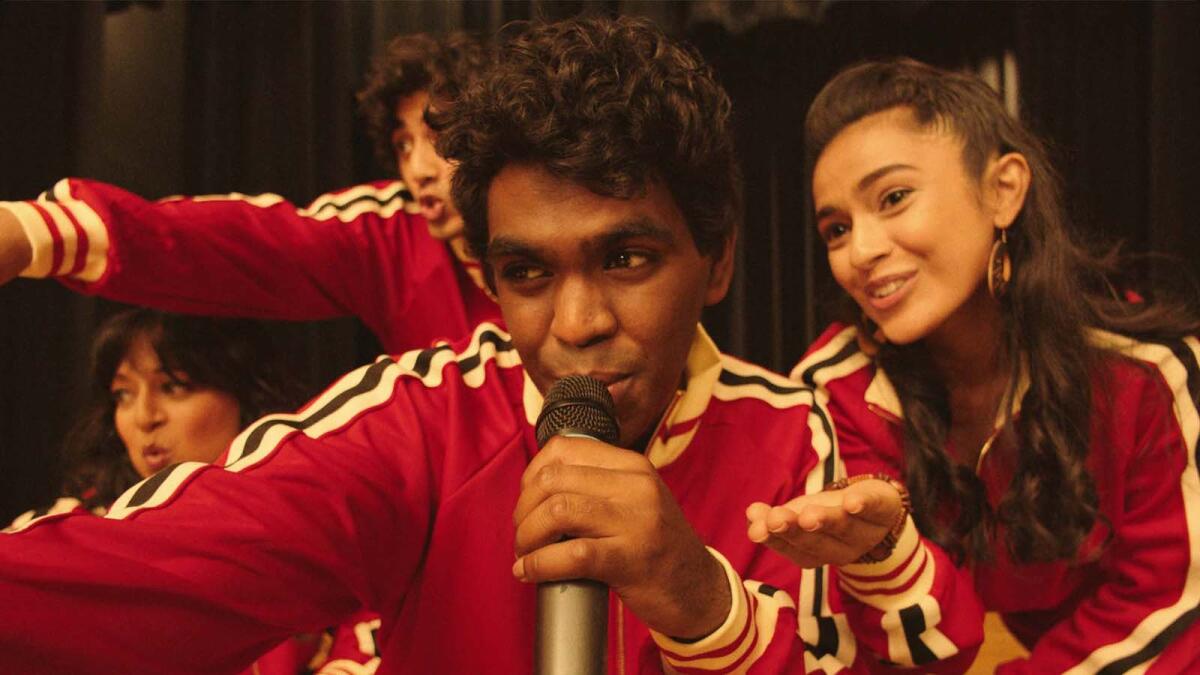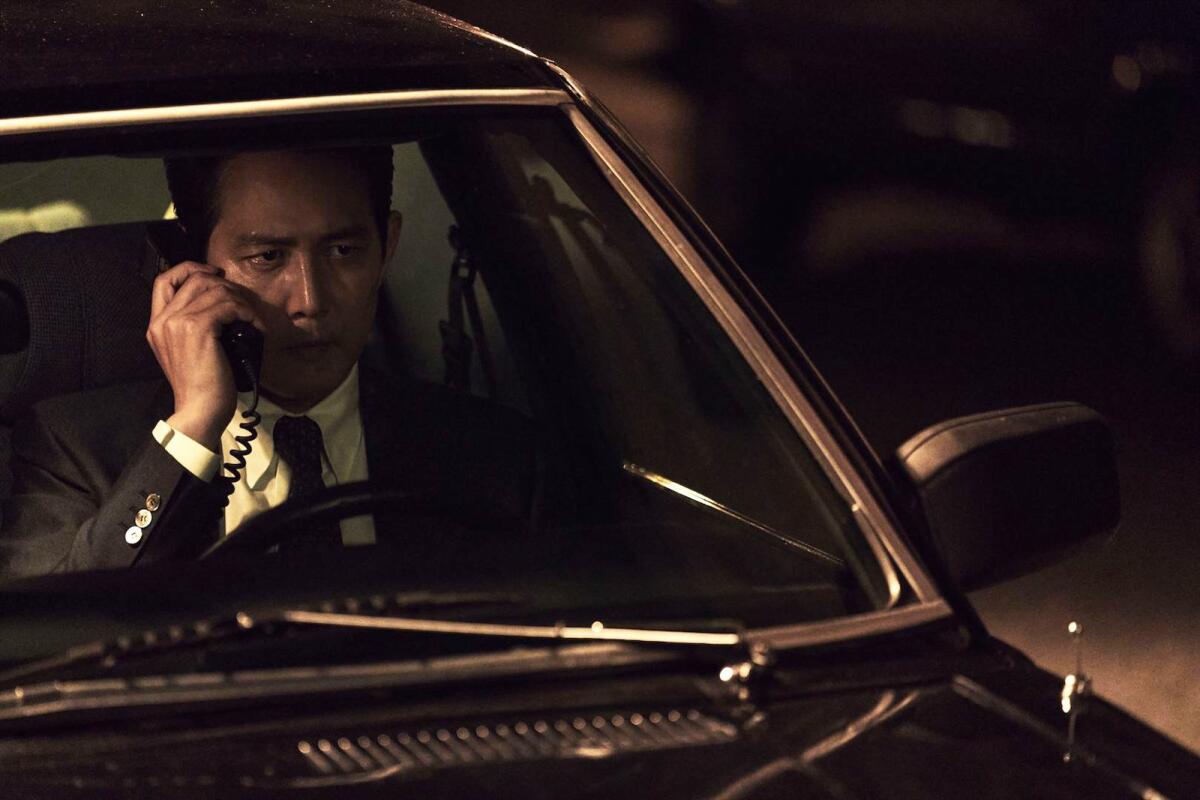Review: Quirky heist movie ‘Four Samosas’ revels in Artesia’s Indian American community

‘Four Samosas’
Set in Artesia’s Little India, the heist comedy “Four Samosas” follows the proud American independent film tradition of underrepresented communities using humor, genre conventions and stylistic flair to win over a broader audience — all while sharing some of what makes their own corner of the country special. Written and directed by the veteran character actor Ravi Kapoor (who previously made the 2015 comedy “Miss India America”), the film hits its stride about halfway through its running time before sputtering down the stretch. But for the most part it’s pretty snappy.
Venk Potula plays Vinny, an aspiring rapper who gets so bothered by his ex-girlfriend’s engagement to a rich snob (Karan Soni) that he puts together a crew to rob his ex’s dowry from a supermarket owned by her father. Much of the first half of “Four Samosas” introduces Vinny’s eclectic accomplices and enemies in quirky little vignettes, shot in pastel colors with precise framing — highly reminiscent of Wes Anderson. We meet the Bollywood fan, the intense scientific genius, the band of cultural reactionaries, the Indian folklore cosplayers and so on.
Post-heist, the movie spins its wheels, struggling to move forward with characters meant to represent, in broad strokes, aspects of the Indian American experience. (Unlike in Wes Anderson’s films, the cartoonish outlines never get the shading they need to add depth.) But Kapoor’s love for these oddballs and their environs is consistently infectious. Its plot may run out of gas, but “Four Samosas” never stops being likable.
‘Four Samosas.’ PG-13, for some language and a rude gesture. 1 hour, 20 minutes. Available on VOD; also playing theatrically, Laemmle Noho 7, North Hollywood; Harkins Cerritos
‘A Wounded Fawn’
In Travis Stevens’ short career as a writer-director (“Girl on the Third Floor,” “Jakob’s Wife”) and his longer career as a producer (“Cheap Thrills,” “We Are Still Here”), his name in the credits of a horror movie has generally been a sign of something special. That’s true yet again with his third feature film, “A Wounded Fawn,” a serial-killer thriller marked by strong performances, a twisty plot, and eye-catching 16mm photography. Throughout, Stevens and his collaborators — including co-screenwriter Nathan Faudree, cinematographer Ksusha Genenfeld and sound designer/composer Vaaal — take familiar ideas and images and give them a fresh pop.
It’s hard to say much about “A Wounded Fawn” without spoiling its surprises; but the story is primarily about Bruce (Josh Ruben), a seemingly nice guy driven by demonic impulses to destroy beautiful women. When Bruce gets too close to a powerful and ancient Greek artifact, he faces a divine judgment — which, if nothing else, ruins the romantic getaway weekend he had planned with his next potential victim, Meredith (Sarah Lind).
Much of the last third of “A Wounded Fawn” is a surreal nightmare, laden with metaphor, which may put off those who are enjoying the movie’s more tightly controlled middle section, which consists of Bruce and Meredith’s increasingly testy dinner date. But the film is really all of a piece in the way it toys with expectations, keeping viewers off-balance. Stevens and company put the audience in the place of both the predator and prey. They’ve built a clever little anxiety-generating machine.
‘A Wounded Fawn.’ Not rated. 1 hour, 31 minutes. Available on Shudder
‘Blood Relatives’
There’s an appealing looseness to writer-director-star Noah Segan’s “Blood Relatives,” a vampire dramedy about a century-old undead creature discovering he has a half-human teenage daughter. Segan plays the sweet-natured monster, Francis, a European Jew who snuck into America after World War II and has been living as a nomadic loner ever since. Victoria Moroles plays Jane, who goes looking for her dad in hopes of finding out why she can’t go out in the sun without slathering on lotion.
Segan doesn’t construct much of a plot for his two bloodsucking heroes. The movie plays like a few episodes of a cable TV sitcom as Francis and Jane have adventures across America: at a funky motel, in a dreary farming town, at a hospital, and ultimately in California, where Dad tries to settle down to give his kid a chance to finish school.
But the lack of urgency to “Blood Relatives” is, on the whole, more of a selling point than a liability. Segan doesn’t force anything. He takes each situation and imagines what might realistically happen — and then what might happen next. He builds a world that feels real, and anchors it with a relationship so wholesome that its easy to see why a lonely vampire would upend his whole existence to preserve it.
‘Blood Relatives.’ Not rated. 1 hour, 28 minutes. Available on Shudder

‘Hunt’
The publicity material for the South Korean political thriller “Hunt” makes it clear that while the movie is fictional, it’s rooted in real history, with a contemporary relevance. That’s actually what gives director-star Lee Jung-jae’s film its drive. Even when this tale of assassination conspiracies and inter-agency law enforcement feuds starts to feel convoluted — and it is undeniably convoluted — its true meaning remains clear.
“Squid Game” star Lee makes his directing debut and plays Park Pyong-ho, chief of the Korean Central Intelligence Agency’s Foreign Unit. Jung Woo-sung plays Kim Jung-do, the KCIA’s Domestic Unit chief. When the government learns of a plot to assassinate South Korea’s president — and the reported involvement of a North Korean spy deep undercover within the KCIA — the two units end up investigating the mole separately, because neither wholly trusts the other.
“Hunt” is set in the 1980s, at a time when South Korea was more authoritarian. Between all the well-staged chases and explosions, Lee focuses a lot of attention on the paranoia of the era as some citizens constantly scrutinize each other, looking to protect themselves by sacrificing their neighbors. “Hunt” works fine as a slam-bang action movie; but at heart it’s more of a cautionary tale.
‘Hunt.’ In Korean with English subtitles. Not rated. 2 hours, 5 minutes. Available on VOD; also playing theatrically, Alamo Drafthouse Cinema, downtown Los Angeles; CGV Cinemas Buena Park
‘Dash’
Writer-director Sean Perry’s dramedy “Dash” is one of the many movies made in the last few years that follow the sometimes strange, sometimes funny, often shocking adventures of ride-share drivers. “Dash” was shot in one take, covering over 90 hectic minutes in the life of Milly (Alexander Molina), a hapless hustler juggling a wife and multiple girlfriends. On this night, Milly begins his dumbest “this’ll fix everything” scheme yet, taking a bag of white powder from one of his lovers and becoming an amateur drug-dealer.
Perry structures “Dash” as a series of extended sketches, some of which are more amusing than others. The characters who book rides with Milly fall into broad “types,” such as goofy tourists, a macho bro and two eye-rolling Gen Z-ers; and their dialogue often sounds more stiff and “writerly” than clever. But Molina gives a good performance as the sleazy Milly. He and Perry are trying to thread a narrow needle, making a selfish, short-sighted doofus into a tragicomic antihero. And while their movie may not be all that original — in fact it actually has a few blatant homages to Quentin Tarantino that border on theft — it is strangely absorbing to see every mistake Milly has ever made pile up into one huge catastrophe.
‘Dash.’ Not rated. 1 hour, 46 minutes. Available on VOD
‘Dio: Dreamers Never Die’
By the time Ronnie James Dio launched his platinum-selling heavy metal band Dio in the early 1980s, he was already in his 40s and had been the frontman for a half-dozen touring and recording acts, dating back to the late 1950s. With a voice ranging between crooning, bluesy and operatic, Dio was capable of singing just about any kind of rock ’n’ roll. But he himself was partial to epic tales of heroes and villains, inspired by ancient myths, classical music and arena-filling bombast.
Dio died of cancer in 2010, at age 67, which means that Don Argott and Demian Fenton’s documentary “Dio: Dreamers Never Die” is missing his perspective on his long and sometimes tumultuous career — outside of his voice in some old interviews. But Argott and Fenton do have input from Dio’s many, many bandmates, as well as his wife Wendy (a producer on the film) and famous fans like Jack Black, Rob Halford and Sebastian Bach. Add in some vintage clips and cool-looking dramatic re-creations — shot to look like faded old home movies — and “Dreamers Never Die” becomes an honest, evocative and at times viscerally exciting look back at one of heavy metal’s headiest and most creative eras.
‘Dio: Dreamers Never Die.’ Not rated. 2 hours, 7 minutes. Available on Showtime Anytime
Also on VOD
“My So-Called High School Rank” is a documentary that takes an unusual approach to the subject of cultural bias in college admissions. Directors Ricki Stern and Annie Sundberg follow the spreading popularity of a new musical theater production called “Ranked” featuring songs and stories about the academic pressure on American teens; and as they check in on rehearsals at schools across the country, they hear from the kids themselves about the hoops they have to jump through these days to get into a top-tier university. Available on HBO Max
Available now on DVD and Blu-ray
“Voices from Ukraine” collects four films from the past decade — “Bad Roads,” “Donbass,” “Reflection” and “The Earth Is Blue As An Orange” — that depict life in Ukraine on the Russian border, before the recent full-scale invasion. The movies offer an enlightening, artful and often surprisingly witty document of how perilous the situation has been between the two countries, before their conflict captured the whole world’s attention. Film Movement
More to Read
Only good movies
Get the Indie Focus newsletter, Mark Olsen's weekly guide to the world of cinema.
You may occasionally receive promotional content from the Los Angeles Times.










